Exhibit - Innovation in Vermont
Vermont has always been a center of innovation and invention. Over the centuries, Vermonters have taken advantage of new technology, developed their own quirky individual solutions to problems, and participated in international conversations about solutions to seemingly intractable problems.
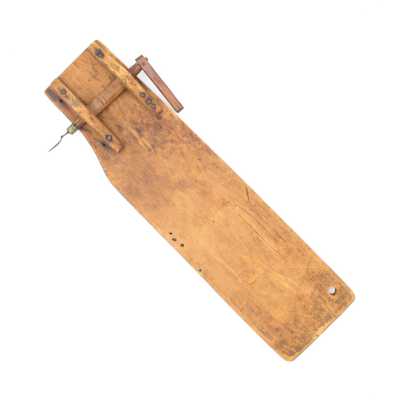
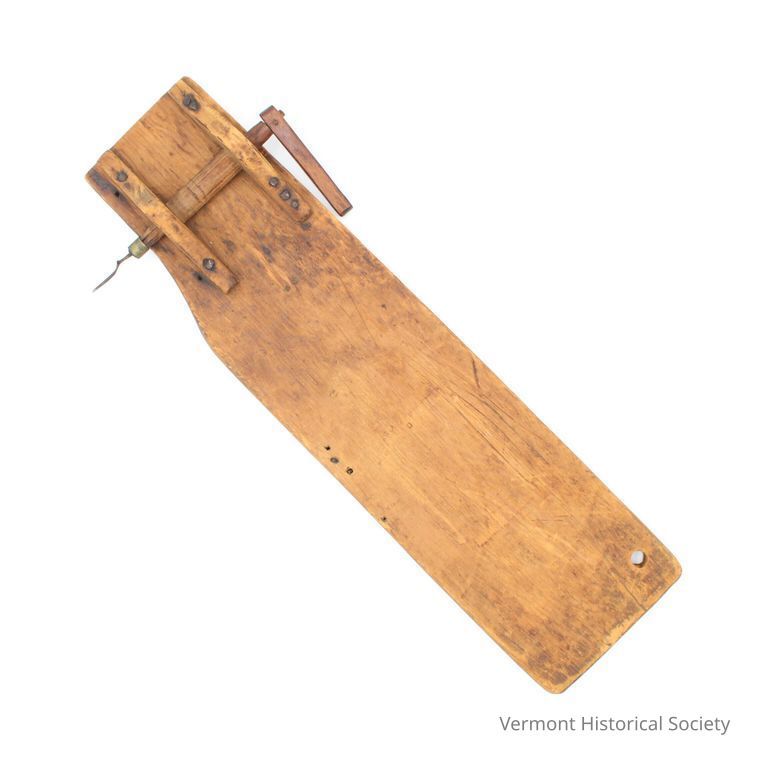
Apple Peeler
Label
Apple Peeler, 1825
Russell Hoyt
Craftsbury, VT
Wood, metal
Gift of Clara Lucena Buswell, 1972.3.2
Apples have always been a core food product for Vermont, and many uses of apples require them to be peeled and cored. Introducing a mechanical device to the process speeds things up considerably, reducing the tedium of the task and preserving more of the apple’s flesh. There are dozens of potential variations on mechanical parers, including many commercially made variations (see 2014.60.1033 in this same exhibition).
This apple parer is homemade and quite simple. It only performs one part of the process: turning the apple. The user would secure the long board part – possibly with clamps or possibly by sitting on it – and stick the apple onto the turning arm. Twirling the lever then rotates the apple, while the user would hold a knife steady to remove the peel. Notably, the tine where the apple would be stuck appears to be a repurposed kitchen implement.
Russell Hoyt of Craftsbury made this apple parer sometime in the 19th century, and passed it down through his family.
Catalog Information
Name/Title
Apple Peeler
Description
Flat wooden board that narrows slightly at one end. On that narrower end are two pieces of wood carved to arch over another wooden cylinder. The two pieces are attached to the board with metal nails at either end.
The wooden cylinder has a handle at one end and metal tines at the other that appears to have been made from a dining fork.
The wooden cylinder has a handle at one end and metal tines at the other that appears to have been made from a dining fork.
Acquisition
Accession
1972.3
Made/Created
Artist Information
Hoyt, Russell (1805-1890)
Artist
Date made
1825
Materials
Material
Wood
Entry/Object ID
1972.3.2
Context
Made and used by Russell Hoyt of Craftsbury, VT

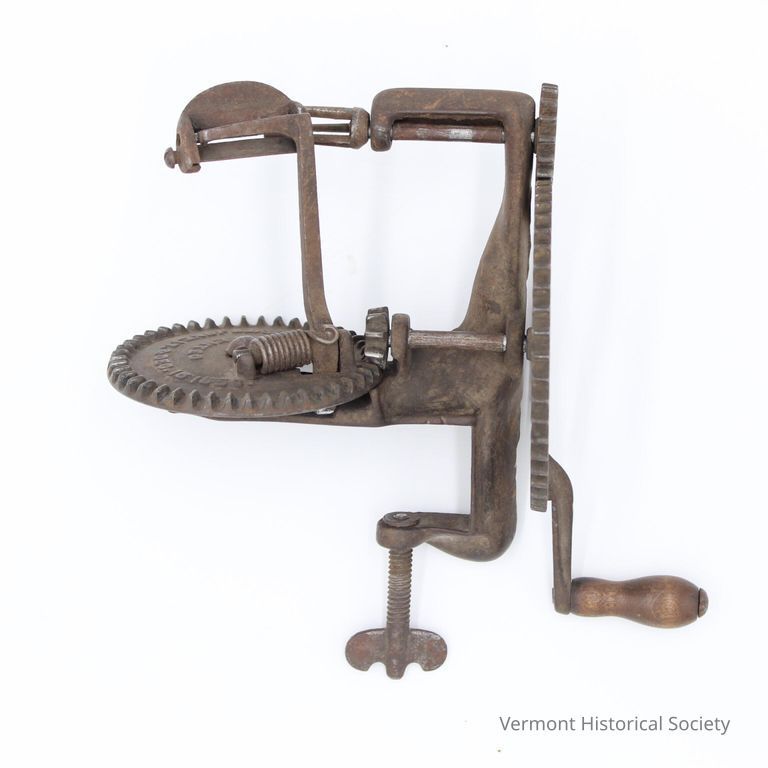
Apple Peeler
Label
Apple Peeler, circa 1856
Horatio Keyes (1830-1904)
Leominster, MA
Cast iron, steel
Barre History Collection, #2014.60.1033
Apples have always been a core food product for Vermont, and many uses of apples require them to be peeled and cored. Introducing a mechanical device to the process speeds things up considerably, reducing the tedium of the task and preserving more of the apple’s flesh. There are dozens of potential variations on mechanical parers, including many homemade variations (see 1972.3.2 in this same exhibition), but this variation, patented by Horatio Keyes in 1856, introduced the idea of moving the paring arm around the apple via a geared turntable, a huge leap forward in speed and convenience.
Catalog Information
Name/Title
Apple Peeler
Description
Metal device known as an apple peeler or parer.
On one end, a vise with a wingnut screw holds the device to a flat surface such as a table or counter. On the side a wooden handle turns a large gear. That gear is connected via two more gears to a center column on a spring, with a horizontal blade at the end. It is also connected to a central shaft at the top of the parer with a three-pronged end.
On the base gear, from which the center column extends, is written “Patented – By H. Keyes June 17 & Dec. 16, 1856.”
When the handle is turned, it activates both the blade and the pronged end. An apple held on the pronged end would rotate around its core while the central blade would move to peel different parts of the apple on a cycle.
On one end, a vise with a wingnut screw holds the device to a flat surface such as a table or counter. On the side a wooden handle turns a large gear. That gear is connected via two more gears to a center column on a spring, with a horizontal blade at the end. It is also connected to a central shaft at the top of the parer with a three-pronged end.
On the base gear, from which the center column extends, is written “Patented – By H. Keyes June 17 & Dec. 16, 1856.”
When the handle is turned, it activates both the blade and the pronged end. An apple held on the pronged end would rotate around its core while the central blade would move to peel different parts of the apple on a cycle.
Acquisition
Accession
2014.60
Made/Created
Date made
circa 1856
Manufacturer
Keyes, Horatio J. (1830-1904)
Dimensions
Width
8-1/2 in
Length
7-1/2 in
Materials
Material
Iron
Entry/Object ID
2014.60.1033
Context
Patented and produced by Horatio Keyes in Leominster, MA, 1856-1857.
Web Links and URLs

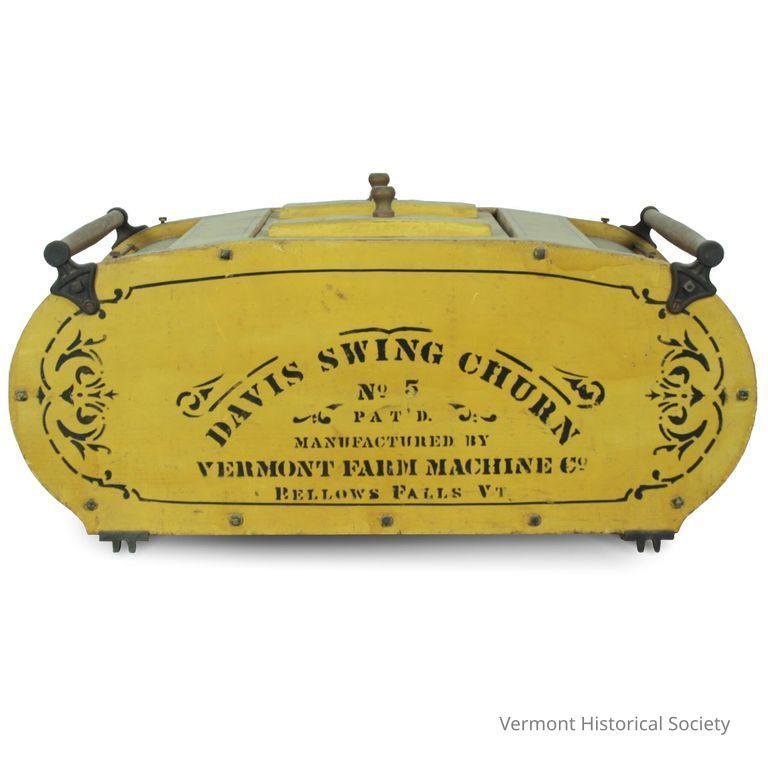
Butter Churn
Label
Butter "Swing" Churn, 1877-1900
Vermont Farm Machinery Company (1871-1921)
Bellows Falls, VT
Wood
Gift of Kathryn O. Jorgensen, #2012.42
The Vermont Farm Machinery Company, based in Bellows Falls, patented this "swing" churn in the 1870s and manufactured it for a number of years after that. Butter is the consolidation of the fat solids contained in milk; farmers would skim the cream from jars of milk as a first step, and then pour the cream into a churn, which would agitate the cream and encourage the fat solids to clump together. On a small scale, this can be done by hand, but in order to produce butter in bulk, some kind of mechanization is necessary. The Davis Swing Churn appeared in a number of sizes, holding between 4 and 50 gallons of cream, depending on the model number. This Model No. 5 could hold 13 gallons of cream. (The Model 9, which held 50 gallons of cream, no longer fit on a frame, and had to be suspended from a ceiling.) The company claimed that the gentle swinging action of the churn did not "injure" the butter.
Catalog Information
Name/Title
Butter Churn
Description
Yellow swing churn, bearing the stenciled label, "Davis Swing Churn/No. 5/Pat'd./Manufactured by/Vermont Farm Machine Co/Bellows Falls VT" in black paint on both long sides. The sides are further decorated with stenciled black decorative borders. There are two turned wooden handles across the top on either end, and metal brackets in the equivalent location on the bottom to attach the church to a wooden frame (now missing). The top of the churn has a door with a clear glass pane to view the contents. The churn has a 13 gallon capacity.
Use
Swung or rocked on a wooden frame to make butter.
Acquisition
Accession
2012.42
Made/Created
Date made
1877-1900
Manufacturer
Vermont Farm Machinery Company (1871-1921)
Materials
Material
Wood, Paint, Iron, Glass
Entry/Object ID
2012.42a-b
Context
Manufactured by Vermont Farm Machine Company in Bellows Falls, VT.
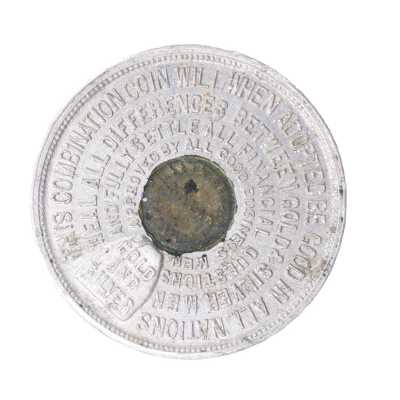
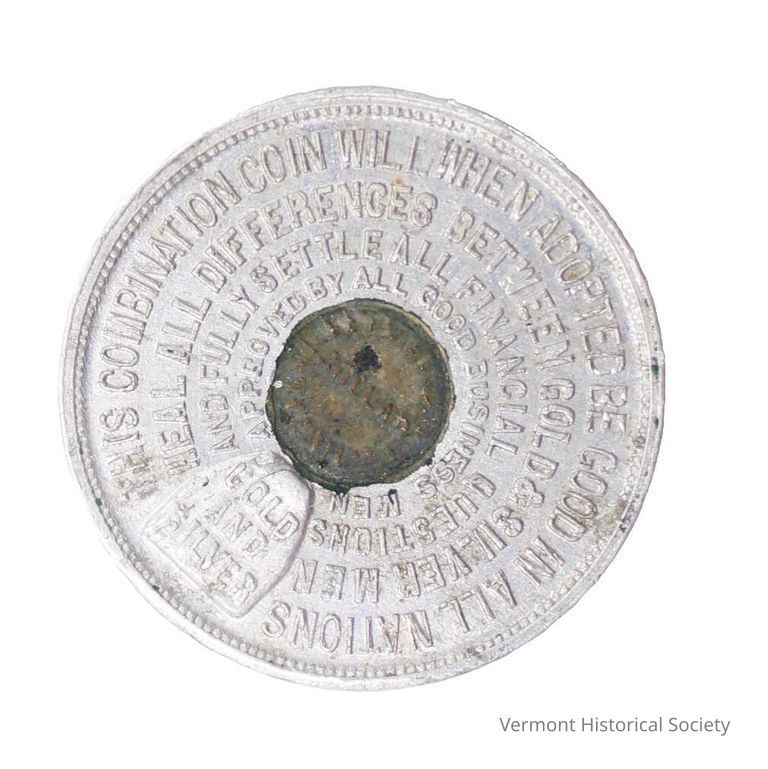
Coin
Label
Coin, 1880-1900
Dana Bickford (1833 - 1909)
Quechee, Vermont
Aluminum, brass
Gift of Ruth R. Smith, 2010.39.2ab
Dana Bickford was born in Quechee when that town was a hotbed of mills and manufacturing, and at various points in his life described himself as both an inventor and an entrepreneur. His biggest success was with an automatic knitting machine that he and several other partners manufactured in Brattleboro in the late 19th century.
This universal coin was one of Bickford's side inventions. After a trip to Europe, he became frustrated with the constant need to exchange currency at each international border, and developed this coin as a solution. In theory, the coin would take on a different value in each country, represented by the amount of base metal (gold and silver) present in the coin. Those values are engraved on the coin itself, relative to the US dollar. Bickford's choices, needless to say, prioritize some countries over the other and assume an international currency exchange that was extremely stable.
Bickford was not alone in attempting to create universal currency; many others had floated the theory or even gone so far as to create coins. None have been successful. Interestingly, Bickford's coin also attempts to heal another monetary divide: it claims to "heal all differences between gold & silvermen," referencing the raging debate in the latter part of the 19th century about whether US currency should be based on the gold or silver standard.
Catalog Information
Name/Title
Coin
Description
Aluminum and brass coin, together with a wooden box. One side of the coin bears the inscription, "This combination coin will when adopted be good in all nations. Heal all differences between gold and silver men and fully settle all financial questions. Approved by all good business men." The other side of the coin bears the inscription, "Here is shown the value of our dollar in the coin of different nations of the world." Below that are eight connected circles, each giving the coin value of a different country, and below that: "Invented & protected by Dana Bickford. Brass insert in center reads "Dollar" with illegible words around it.
The box has a sliding cover and an indentation for the coin in the bottom.
The box has a sliding cover and an indentation for the coin in the bottom.
Acquisition
Accession
2010.39
Made/Created
Artist Information
Bickford, Dana
Artist
Date made
1880-1900
Dimensions
N/A
Materials
Material
Brass, Aluminum, Wood
Entry/Object ID
2010.39.2a-b
Context
Developed by Dana Bickford of Quechee, VT to be a universal monetary exchange medium.
Web Links and URLs
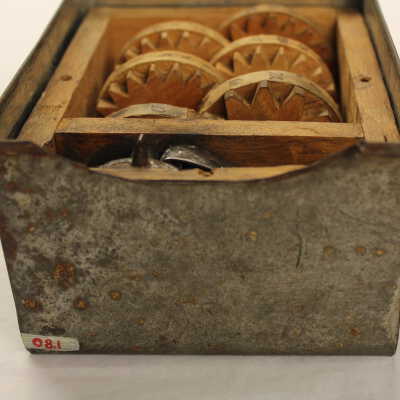
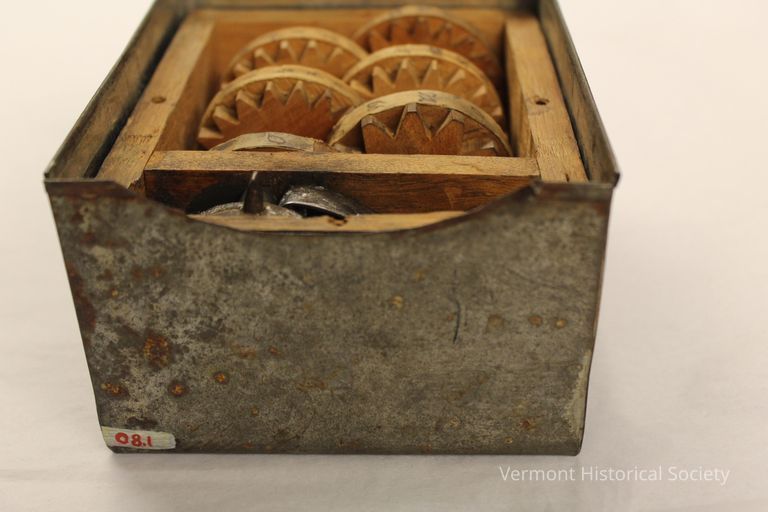
Cyclometer
Label
Cyclometer, 1841
Oren Cummins
Montpelier, VT
Wood, metal
Gift of Albert O. Cummins, 1908.1
For as long as people have been traveling, they have wanted to know how fast they were going and how far they’ve traveled. The cyclometer (the word means “circle-measurer”) does just that. Today, cyclometers usually employ GPS to track movement, but before that technology was available, analog versions did the same job.
This cyclometer was created by Oren Cummins of Montpelier in 1841, and is entirely handmade. The concept of measuring distance was not new, but Cummins’s solution is noteworthy because it so clearly depended entirely on his own ingenuity to implement. The gears are hand-cut and hand-numbered, and the whole is a remarkable combination of applied mathematics and precision crafting.
Cummins used his cyclometer on carriage wheels. One end of the cyclometer would be attached to the hub of the wheel, and as the wheel turned, it would begin the tracking. Gears closer to the wheel measured shorter distances, and when they completed a certain number of revolutions they would trigger the next wheel to advance, and so on down the line. Ultimately, this cyclometer was capable of recording up to 40,000 miles.
Catalog Information
Name/Title
Cyclometer
Description
Handmade cyclometer consisting of a wooden box with six wooden gears and two metal gears.
The box sits in an outer metal case and is divided into two compartments. The narrower compartment on one side houses two offset metal gears connected to each other. The larger compartment houses six additional gears, also offset and connected to each other, three in a row. The gears are connected by two wooden center pieces that allow them to spin.
The wooden gears are also hand-numbered with various intervals specific to each gear.
The box sits in an outer metal case and is divided into two compartments. The narrower compartment on one side houses two offset metal gears connected to each other. The larger compartment houses six additional gears, also offset and connected to each other, three in a row. The gears are connected by two wooden center pieces that allow them to spin.
The wooden gears are also hand-numbered with various intervals specific to each gear.
Use
Used to measure the distance traveled by a carriage or wagon wheel.
Acquisition
Accession
1908.1
Made/Created
Artist Information
Cummins, Oren
Artist
Date made
circa 1841
Dimensions
Width
5-1/2 in
Height
4-1/2 in
Diameter
3 in
Materials
Material
Wood, Metal
Entry/Object ID
1908.1
Context
Made by Oren Cummins of Montpelier, VT in 1841.
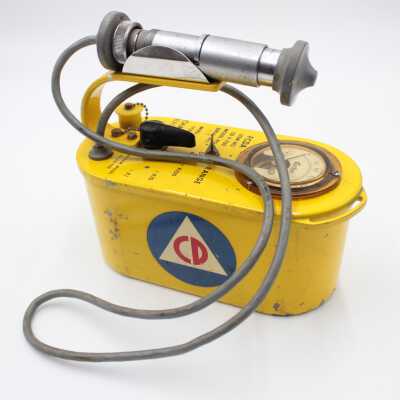
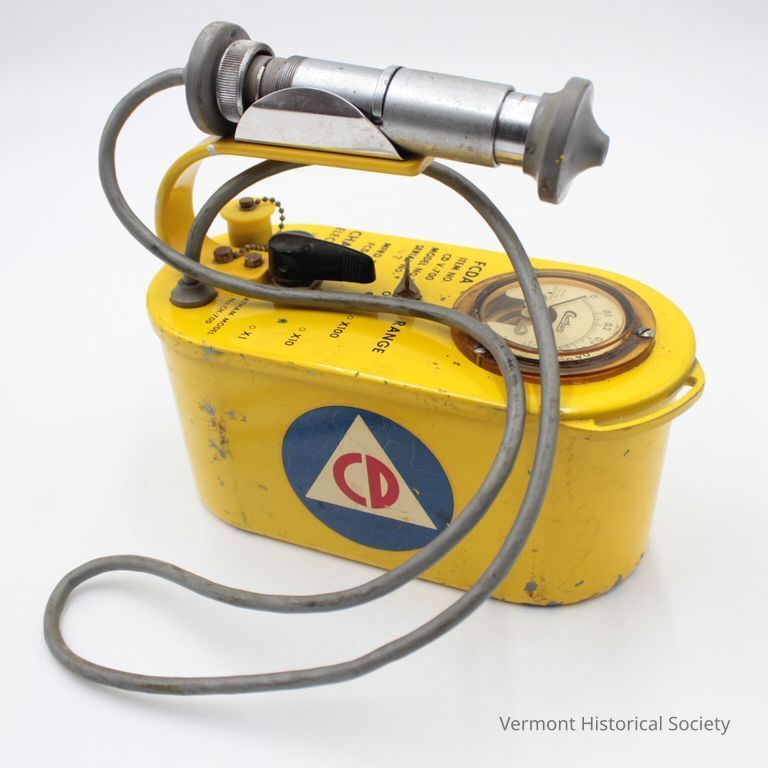
Geiger Counter
Label
Geiger Counter, 1957
Chatham Electronics
Metal, rubber, plastic
Given in Memory of Dr. O.S. Peterson, Jr., 2004.35.1ab
A Geiger counter, named after scientist Hans Geiger, is a device used to detect and measure radiation. The unit consists of two parts: a probe and the body, which has a measurement window as well as the Geiger-Muller tube, which actually registers the radiation. Geiger counters are inexpensive, easy to use, and widely available pieces of technology.
The world entered the atomic age after the US bombings of Hiroshima and Nagasaki, and for several decades the threat of a potential nuclear war gripped both the public and the American government. National civil defense programs produced short films, radio ads, pamphlets, posters, and other educational programs designed to educate citizens about how to act after a nuclear attack. Those decades of preparation, worry, and international diplomatic maneuvering are today known as the Cold War.
The Geiger counter in the collection of the Vermont Historical Society was used by Dr. Oscar S. Peterson, Jr. in his role as radiological officer for the State Civil Defense Agency. (The “CD” symbol on the side of the unit stands for Civil Defense.) It formed part of his personal kit, intended to detect and investigate any signs of nuclear fallout.
The Cold War was a period during which Vermonters had a complicated relationship with innovation and technology. They had to integrate both the threat of nuclear war and the fast-paced advances of modern society in their worldviews simultaneously. Few things illustrate this tension quite like a Geiger counter, which was meant to be used in a disaster scenario – but could guide the way to safety.
Catalog Information
Name/Title
Geiger Counter
Description
Yellow geiger counter and instruction manual. The counter has a rectangular yellow case with curved ends. Each long side has a log consisting of a white triangle inside a blue circle with the letters "CD" in red. A dial on the top has a numerical range from 0 to 0.5., and is encased beneath a plastic cover, held on with screws. The printing on the top of the case reads, "FCDA / ITEM NO. / CD V-700 / MODEL NO. 3 / SERIAL NO. / 667 / MFRD. FOR / FCDA BY / CHATHAM / ELECTRONICS / LIVINGSTON / NEW JERSEY". There are two black plastic knobs and a yellow plastic plug on the top of the case. A U-shaped bar extends from the case to act a both a handle and a holster for a silver-toned tube, connected to the case by a rubber-encased cord, and capped on either end with rubber. The counter is accompanied by a 15-page manual entitled "Radiological Survey Meter / FCDA ITEM NO. CD V-700" printed in black and white on glossy paper.
Acquisition
Accession
2004.35
Relationships
Related Person or Organization
Peterson, Oscar S., Jr. (1912-1988), University of Vermont
Made/Created
Date made
1957
Manufacturer
Chatham Electronics
Dimensions
Width
4 in
Height
7 in
Length
7-3/4 in
Materials
Material
Aluminum, Rubber, Plastic
Entry/Object ID
2004.35.1a
Context
Used by Dr. Oscar S. Peterson, Jr. while working with Civil Defense in Vermont
Web Links and URLs
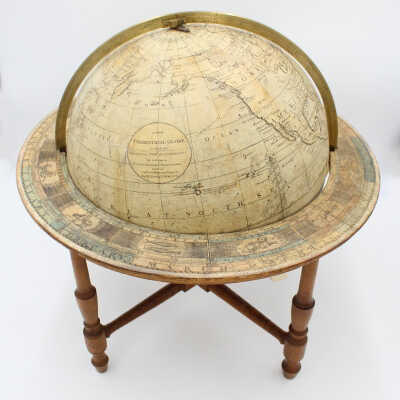
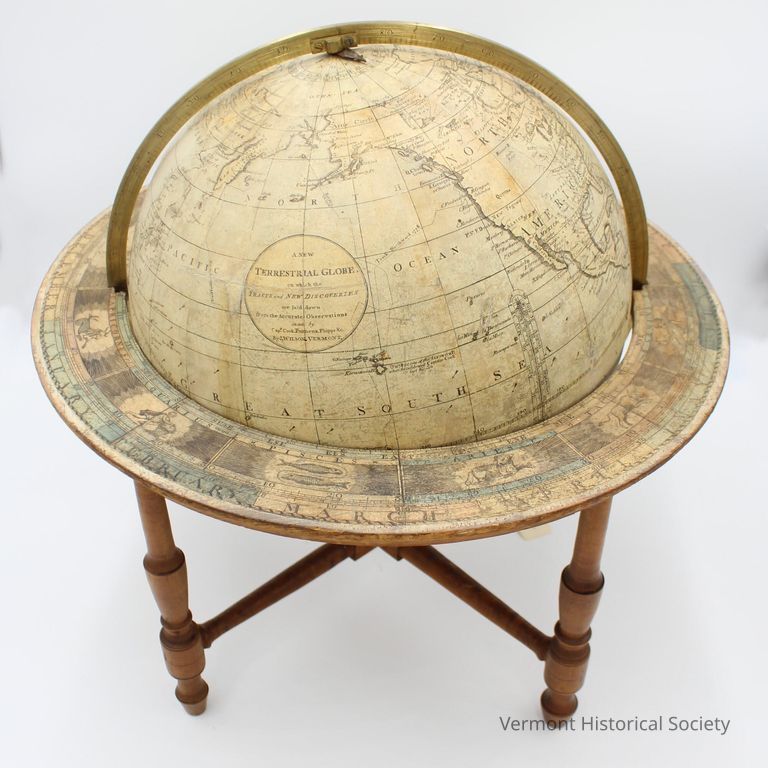
Globe
Label
Globe, 1810-1819
James Wilson
Bradford, VT
Wood, paper, brass
Anonymous gift, 1921.16
James Wilson of Bradford was raised on a farm and trained briefly as a blacksmith. He moved to Bradford as a young man in 1796 and became interested in cartography. After visiting Dartmouth College's map collection, he grew particularly enamored of globes, and set out to make his own. It took several years of experimentation and learning new skills - he was almost exclusively self-taught - but Wilson began officially manufacturing his globes in 1813. Producing a high-quality globe required mastering a variety of skills - printing, engraving, woodworking, and blacksmithing - all with a high degree of precision.
Wilson manufactured a variety of globes, including a line of papier-mache globes that he could produce and sell inexpensively. His globes were the first to be manufactured in America, and found a ready audience in schools in particular. This globe was not among his first run, but was produced later, in 1816. The Wilson Manufacturing Company continued to produce globes in Vermont and New York for nearly fifty years.
Catalog Information
Name/Title
Globe
Description
World globe printed on paper that is glued onto a hollow wooden sphere. The sphere rests in a stand made of wood and brass, and spins freely in two directions. The brass portion encircles the globe vertically, and is marked with measurement hash marks and numbers meant to indicate longitude. The wooden stand encircles the globe horizontally and on its flat surface there are more printed paper designs depicting astrological signs. The horizontal piece also includes measurement hash marks meant to indicate latitude.
The wooden stand is supported on four turned legs that are connected crosswise in the center. The globe can spin freely or be locked in place by making adjustments to the brass piece.
On the legend on the globe is printed the explanatory text: "A NEW / TERRESTRIAL GLOBE, / on which the / TRACTS and NEW DISCOVERIES / are laid down / from the Accurate Observations / made by / Cap.t. Cook, Furneux, Phipps & C. / By J. WILSON, VERMONT."
The wooden stand is supported on four turned legs that are connected crosswise in the center. The globe can spin freely or be locked in place by making adjustments to the brass piece.
On the legend on the globe is printed the explanatory text: "A NEW / TERRESTRIAL GLOBE, / on which the / TRACTS and NEW DISCOVERIES / are laid down / from the Accurate Observations / made by / Cap.t. Cook, Furneux, Phipps & C. / By J. WILSON, VERMONT."
Acquisition
Accession
1921.16
Made/Created
Artist Information
Wilson, James (1763-1855)
Artist
Date made
circa 1810
Manufacturer
Wilson Manufacturing Company
Dimensions
Width
18 in
Height
18-3/4 in
Materials
Material
Paper, Wood, Brass
Entry/Object ID
1921.16
Context
Made by Wilson Manufacturing Company in Bradford, VT.
Web Links and URLs
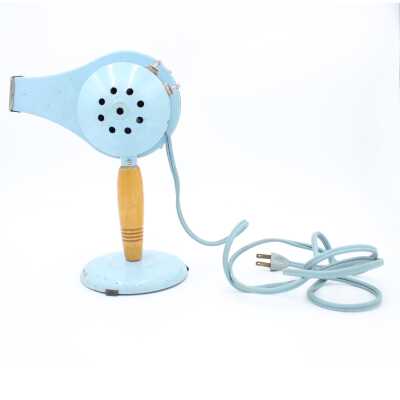
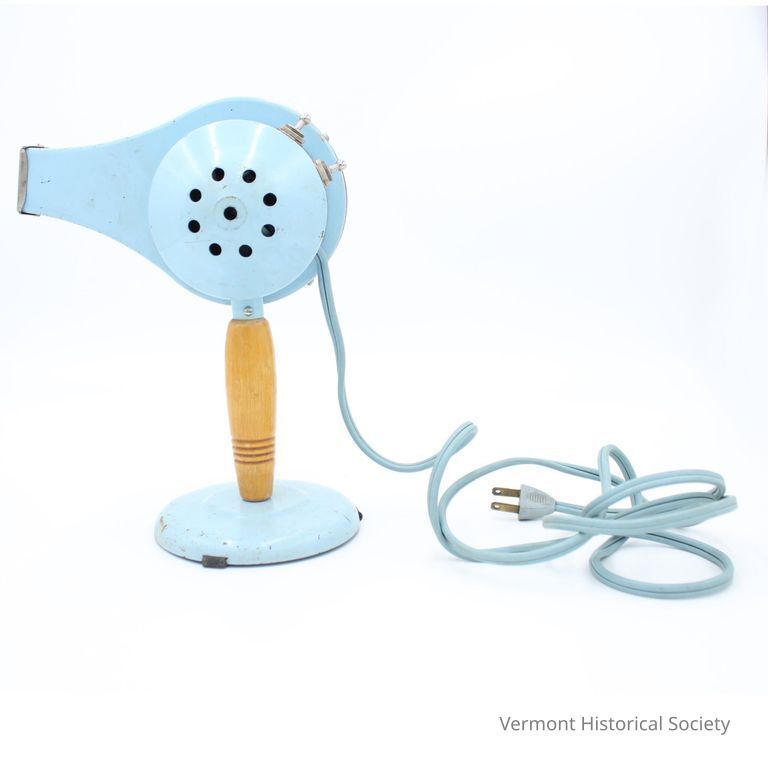
Hair Dryer
Label
Hair Dryer, 1950-1960
Standard Products Corp.
Whitman, MA
Metal
Gift of Olive Romerio Franzi, 2008.59.5ab
Some innovations are no less important because they are small and highly personal. The hair dryer was invented in France in the 1890s, and became available for personal purchase in the 1920s. By the 1950s and 1960s, two major changes had greatly improved the tool: using plastic for the casing, making it lighter and easier to hold up for the necessary time, and an improved electrical motor, making it heat up faster and more efficiently.
Millions of American women entered the workforce during World War II, and many of them never left, continuing to make gains through the second half of the 20th century. With that rising tide of women’s participation in the economy and the business life of America came the need for less expensive, more accessible beauty products, of which the hair dryer was one.
This hair dryer, the “Handy Hannah” model, was made out of metal, but had other improvements: it was one of the first to introduce a heat control mechanism. It was especially popular during the 1950s, and belonged to a woman in Montpelier whose career spanned five decades with Green Mountain Power.
Catalog Information
Name/Title
Hair Dryer
Description
Blue metal electric hair dryer on a stand. Dryer removes from the stand to become a hand-held model. There are two switches, one for ON/OFF and one for HOT/COLD. A metal plate attached to the hand-held piece identifies this as a HANDY-HANNAH electric Hair dryer from the Standard Products Corp, Whitman, Mass. It states 215 watts - 110 - 20 volts, A.C. only, 50-60 cycles, Cat No. 595. It also has the UL symbol. The handle is a light colored wood. The electric cord is blue.
a= dryer
b=stand
a= dryer
b=stand
Acquisition
Accession
2008.59
Relationships
Related Places
Place
Montpelier
City
Washington County
County
Vermont
State/Province
United States of America
Country
North America
Made/Created
Date made
1950-1960
Manufacturer
Standard Products Corporation
Dimensions
Width
7-1/4 in
Height
9-1/2 in
Depth
5 in
Materials
Material
Metal, Wood
Entry/Object ID
2008.59.5a-b

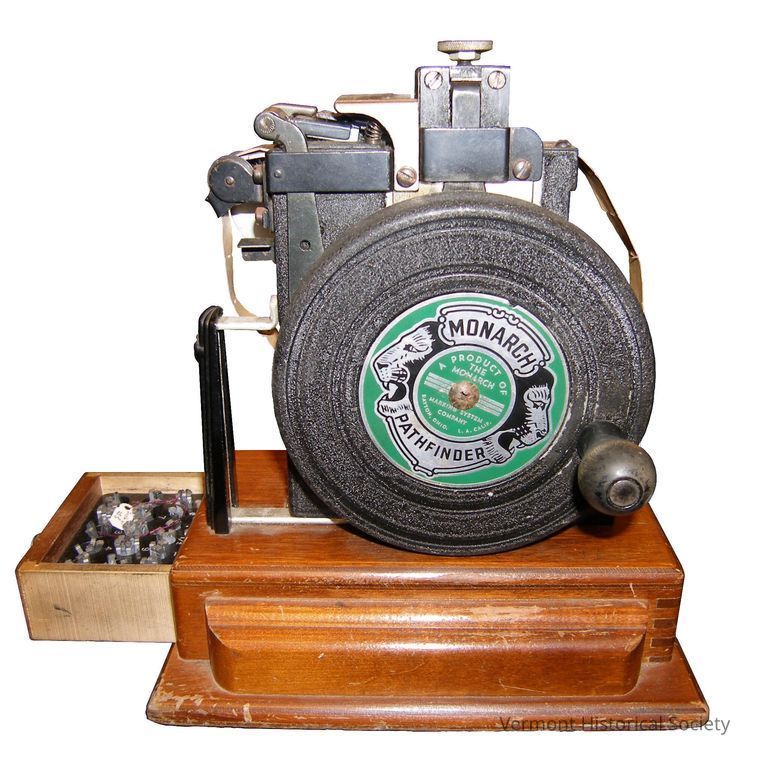
Label Printer
Label
Monarch Pathfinder Label Printer, 1915
Monarch Marking System Company (1901-present)
Dayton, OH
Metal, wood
Gift of Edward Corrigan, #2006.61.25
Some pieces of technology in Vermont were widely available commercially and highly specific to their specific jobs. This label printing machine came from The Homer Fitts Company, a clothing and dry goods store that operated on Main Street in Barre for 120 years, from 1886-2006. It was used to create price tags and could be customized in-house using the interchangeable type in the drawer on the bottom. Interestingly, Monarch still makes a label printer called the Pathfinder today.
Catalog Information
Name/Title
Label Printer
Description
Crank printing press for stamping out price tags, with drawer at bottom containing price type (numbers and letters).
The main unit is black metal with an inside space for housing a roll of blank price tags. On the right side is a circular crank with a wooden knob. The type is inserted into a mechanism at the top, which contains rollers and an ink pad. The tags thread through to the front where they may be individually torn off. Along side this is a metal attachment which reads: "Insert ticket strip here and push to here" with an arrow indicating direction. The blank price tags are imprinted at the top: "The Homer Fitts Co./ Barre, Vermont". A circular metal green label with black printing is attached to the metal crank on the side and imprinted: "MONARCH PATHFINDER" with a lion's heads on each side, and printed in the center: "A Product of THE MONARCH/ Marking System Company/ Dayton, Ohio. L.A. Calif." This metal unit sits on a wooden base and has a metal label attached to front which reads: "THE/ MONARCH/ MARKING SYSTEM COMPANY" and gives factory locations, patent numbers and model number.
A drawer in the wooden base holds the metal letters and numbers.
The main unit is black metal with an inside space for housing a roll of blank price tags. On the right side is a circular crank with a wooden knob. The type is inserted into a mechanism at the top, which contains rollers and an ink pad. The tags thread through to the front where they may be individually torn off. Along side this is a metal attachment which reads: "Insert ticket strip here and push to here" with an arrow indicating direction. The blank price tags are imprinted at the top: "The Homer Fitts Co./ Barre, Vermont". A circular metal green label with black printing is attached to the metal crank on the side and imprinted: "MONARCH PATHFINDER" with a lion's heads on each side, and printed in the center: "A Product of THE MONARCH/ Marking System Company/ Dayton, Ohio. L.A. Calif." This metal unit sits on a wooden base and has a metal label attached to front which reads: "THE/ MONARCH/ MARKING SYSTEM COMPANY" and gives factory locations, patent numbers and model number.
A drawer in the wooden base holds the metal letters and numbers.
Acquisition
Accession
2006.61
Relationships
Related Person or Organization
The Homer Fitts Company
Person or Organization
Related Places
Place
Barre City
City
Washington County
County
Vermont
State/Province
United States of America
Country
North America
Made/Created
Date made
1915
Manufacturer
Monarch Marking System Company (1901-present)
Dimensions
N/A
Materials
Material
Metal, Paper, Wood
Entry/Object ID
2006.61.25a-b
Context
Used in the Homer Fitts Store in Barre, Vermont


Patent Model
Label
Patent Model, ca. 1878
George H. Soule Company
St. Albans, VT
Metal
Gift of Cary H. Keith, 1985.21.1a-c
George Henry Soule was born on a farm in Fairfield in 1865, and after attending Goddard Seminary in Barre, returned to take over his family’s maple sugaring operations. By 1905, the Soule family farm was one of the largest maple producers in New England, with as many as 8,000 taps.
Soule began experimenting with sugaring technology in the 1890s, and soon sought a series of patents for various inventions including evaporators, sap spouts, and other equipment for gathering sap. Many of his designs were produced by other companies, but in 1915 he formed his own company to manufacture his products.
The “King” Evaporator (possibly a nod to Soule’s nickname “Maple Sugar King”) was the Soule company’s signature model and featured a number of innovations. Soule himself passed away in 1937, but the Soule Company continued to produce maple equipment through the 20th century.
Maple has long been one of Vermont’s most important export products, and Soule’s life and work aligned perfectly with the shift away from a maple sugar-based market to a liquid maple syrup market. That shift required innovation and creativity, and made a permanent mark on Vermont’s economy and image.
Catalog Information
Name/Title
Patent Model
Description
Patent model for a maple sap evaporator, in three parts.
There are two trays that rest on top of a base piece. The two trays hook together in the center. The left tray has some figured piping and the bottom of the pan is slats with gaps between them. It is divided horizontally into two parts. The right tray is divided horizontally into three parts, with a sealed base.
The base piece is supported by two legs on its left side and a rectangular base on its right side. On the left side, above the legs, it extends past the left tray and has a small oval opening. The base piece is formed generally into an arch. The left side of the base is a shallow pan, with a slant down to a deeper section that has slats at the bottom.
The entire model is metal, painted silver, and features the label “SOULES KING EVAPORATOR AND ARCH / Mfg By / GEO. H. SOULE CO. / St. Albans, Vt.
There are two trays that rest on top of a base piece. The two trays hook together in the center. The left tray has some figured piping and the bottom of the pan is slats with gaps between them. It is divided horizontally into two parts. The right tray is divided horizontally into three parts, with a sealed base.
The base piece is supported by two legs on its left side and a rectangular base on its right side. On the left side, above the legs, it extends past the left tray and has a small oval opening. The base piece is formed generally into an arch. The left side of the base is a shallow pan, with a slant down to a deeper section that has slats at the bottom.
The entire model is metal, painted silver, and features the label “SOULES KING EVAPORATOR AND ARCH / Mfg By / GEO. H. SOULE CO. / St. Albans, Vt.
Acquisition
Accession
1985.21
Made/Created
Date made
circa 1878
Manufacturer
George H. Soule Company
Dimensions
Length
13 in
Materials
Material
Metal
Entry/Object ID
1985.21.1a-c
Context
Made by George H. Soule Company in St. Albans, VT


Patent Model
Label
Patent Model, 1868
Benjamin F. Wheeler
Calais, Vermont
Wood, metal
Gift of Myrtie B. Wheeler, 1966.19.1
The United States Patent and Trademark Office required inventors to submit a patent model for their designs from 1790 – 1880. Models could be no larger than 12” in any direction. The requirement was a way to make the patent process accessible to homegrown inventors who might not have the drafting or engineering expertise necessary to submit a full, formal patent application. Inventors can still submit a patent model today, particularly in situations where a working model would provide better evidence of their design than the patent application itself. Thanks to several fires at the patent offices in Washington, D.C., many patent models have been lost over the years; others were dispersed in subsequent sales. The Vermont Historical Society possesses a number of patent models related to Vermont inventions.
This patent model showing a new design for carriage brakes was submitted by Benjamin Wheeler. We don’t know much about him other than he primarily worked as a farmer, and submitted this and one patent for a carriage braking system, also in the VHS collections (1966.19.1).
Catalog Information
Name/Title
Patent Model
Description
Patent model of a new system for sleigh brakes.
The model is of the chassis system of a sleigh only, constructed from metal and wood. The wood is painted blue. The sleigh rails are in two pieces, and the chassis can pivot at the center. The braking system can be activated from the middle of the chassis, and drops a metal hook down from the rear of the chassis to drag into the snow.
On a strip of wood at the front of the chassis is a small metal plaque with the inscription “B.F. WHEELER’S / PATENT JULY 21ST 1868”
The model is of the chassis system of a sleigh only, constructed from metal and wood. The wood is painted blue. The sleigh rails are in two pieces, and the chassis can pivot at the center. The braking system can be activated from the middle of the chassis, and drops a metal hook down from the rear of the chassis to drag into the snow.
On a strip of wood at the front of the chassis is a small metal plaque with the inscription “B.F. WHEELER’S / PATENT JULY 21ST 1868”
Acquisition
Accession
1966.19
Made/Created
Artist Information
Wheeler, Benjamin F.
Artist
Date made
1868
Dimensions
Width
5 in
Height
2-3/4 in
Length
19 in
Materials
Material
Wood, Metal
Entry/Object ID
1966.19.1
Context
Made by Benjamin F. Wheeler of Calais, Vermont
Label from an exhibit says, "The brakes were constructed so that as the horses slowed, they applied a stopping force equal to the forward pressure of the load. If the driver wanted to back up, the brakes could easily be readjusted."
Label from an exhibit says, "The brakes were constructed so that as the horses slowed, they applied a stopping force equal to the forward pressure of the load. If the driver wanted to back up, the brakes could easily be readjusted."


Patent Model
Label
Patent Model
Benjamin F. Wheeler
Calais, Vermont
Wood, metal
Gift of Myrtie B. Wheeler, 1966.19.2ab
The United States Patent and Trademark Office required inventors to submit a patent model for their designs from 1790 – 1880. Models could be no larger than 12” in any direction. The requirement was a way to make the patent process accessible to homegrown inventors who might not have the drafting or engineering expertise necessary to submit a full, formal patent application. Inventors can still submit a patent model today, particularly in situations where a working model would provide better evidence of their design than the patent application itself. Thanks to several fires at the patent offices in Washington, D.C., many patent models have been lost over the years; others were dispersed in subsequent sales. The Vermont Historical Society possesses a number of patent models related to Vermont inventions.
This patent model showing a new design for carriage brakes was submitted by Benjamin Wheeler. We don’t know much about him other than he primarily worked as a farmer, and submitted this and one patent for a sleigh braking system, also in the VHS collections (1966.19.1).
Catalog Information
Name/Title
Patent Model
Description
Patent model of a new system for carriage brakes.
The model is just the chassis and wheels of the carriage, in two pieces. The pieces are held together through a pin that connects the front axle to the body of the chassis.
The whole chassis is made of wood and metal, with four wheels, the front pair smaller than the rear. The braking system is activated when the carriage rolls backward, or by a hand brake that is connected to a lever at the left front of the chassis.
The brakes themselves are in front of the rear carriage wheels, held in place by a strip going horizontally across the width of the chassis. When the lever is activated, the wood strip slides backwards and engages the brakes.
The model is just the chassis and wheels of the carriage, in two pieces. The pieces are held together through a pin that connects the front axle to the body of the chassis.
The whole chassis is made of wood and metal, with four wheels, the front pair smaller than the rear. The braking system is activated when the carriage rolls backward, or by a hand brake that is connected to a lever at the left front of the chassis.
The brakes themselves are in front of the rear carriage wheels, held in place by a strip going horizontally across the width of the chassis. When the lever is activated, the wood strip slides backwards and engages the brakes.
Acquisition
Accession
1966.19
Made/Created
Artist Information
Wheeler, Benjamin F.
Artist
Date made
1868
Dimensions
Width
10 in
Height
7-1/2 in
Length
23 in
Materials
Material
Wood, Metal
Entry/Object ID
1966.19.2a-b
Context
Made by Benjamin F. Wheeler of Calais, VT
From a label in an exhibit: "The self-acting brake no longer stopped forward motion, but prevented a wagon from rolling backward when it was ascending a hill."
From a label in an exhibit: "The self-acting brake no longer stopped forward motion, but prevented a wagon from rolling backward when it was ascending a hill."


Product Model
Label
Sales Sample, 1883
William Cooley
Vermont Farm Machinery Company
Wood, metal
Anonymous gift, 1957.19
Dairy has long been one of Vermont’s primary industries, and when refrigerated railroad cars provided easier, faster access to major markets in Montreal, New York, and Boston, production grew exponentially. Rather than cheese and other preserved products as the primary export, it became feasible for Vermonters to sell cream and milk out of the state.
William Cooley of Waterbury invented a number of things, including a variety of gasoline engines, granite industry tools, and other machine parts. This creamer was one of his earlier efforts, patented in the 1870s. The creamer was found to be more efficient at extracting cream from milk than other similar machines, and the Vermont Farm Machine Company purchased the patent from Cooley to manufacture and distribute his machine.
Within a few years, 8,000 dairies were using the creamer. Its more efficient process made the development of centralized creameries possible, streamlining production rather than the individual on-farm process that had dominated before. The design proved popular enough that the company spent time in court protecting its patent against infringement on a number of different occasions.
This creamer is a salesman’s model, intended to show the mechanics of the machine but not necessarily to actually produce cream. The smallest production model of Cooley’s Creamer was at least twice as large as this one.
Catalog Information
Name/Title
Product Model
Description
Sales sample for a Cooley Creamer, manufactured by the Vermont Farm Machinery Company.
Wooden box painted green, gold, and black with a tin lined interior. On the outside of the box are elaborate painted decorations as well as the lettering “COOLEY CREAMER” at the top front in black letters shadowed with gold. On the front gold panels are the words “MANUF’D BY / VERMONT FARM MACHINE CO / BELLOWS FALLS, VT, U.S.A. / PATENTS ISSUED / FEB 10 1877, AUG 28 1877, JULY 17, 1883” There is also a metal slot on the top of the front panel above the words. The whole box is held off the ground by two pieces of wood on the bottom. On the right hand side is a crank connected to three gears as well as two additional levers.
On the underside of the lid, the words “INVENTED BY / WILLIAM COOLEY / OF WATERBURY, VT.” are painted in black. The lid is held open by two chains connecting diagonally to the box. Inside the box, four metal cylinders rest on a platform that raises or lowers with a system of gears. The cans have spigots and gauges and removable lids.
Wooden box painted green, gold, and black with a tin lined interior. On the outside of the box are elaborate painted decorations as well as the lettering “COOLEY CREAMER” at the top front in black letters shadowed with gold. On the front gold panels are the words “MANUF’D BY / VERMONT FARM MACHINE CO / BELLOWS FALLS, VT, U.S.A. / PATENTS ISSUED / FEB 10 1877, AUG 28 1877, JULY 17, 1883” There is also a metal slot on the top of the front panel above the words. The whole box is held off the ground by two pieces of wood on the bottom. On the right hand side is a crank connected to three gears as well as two additional levers.
On the underside of the lid, the words “INVENTED BY / WILLIAM COOLEY / OF WATERBURY, VT.” are painted in black. The lid is held open by two chains connecting diagonally to the box. Inside the box, four metal cylinders rest on a platform that raises or lowers with a system of gears. The cans have spigots and gauges and removable lids.
Acquisition
Accession
1957.19
Relationships
Related Places
Place
Waterbury
Town
Washington County
County
Vermont
State/Province
United States of America
Country
North America
Made/Created
Artist Information
Cooley, William
Artist
Date made
1883
Manufacturer
Vermont Farm Machinery Company (1871-1921)
Dimensions
Width
21-1/2 in
Height
16-1/2 in
Depth
15-3/4 in
Materials
Material
Wood, Metal
Entry/Object ID
1957.19
Context
William Cooley of Waterbury patented this creamer in the 1870s as the dairy industry began booming, and it was sold and distributed nationally by the Vermont Farm Manufacturing Company of Bellows Falls.


Radio
Label
Radio, 1929
Atwater Kent Manufacturing Company
Philadelphia, PA
Wood, metal, glass
Gift of David Stone, 1978.14.1a-c
Arthur Atwater Kent was born in Burlington, but moved to Worcester, MA with his family as a child. He spent some time studying at the Worcester Polytechnic Institute but did not graduate, having already begun his own business making small electric motors, generators, fans, and an automobile ignition system of his own design.
In 1921, he began making radio parts, selling them as do-it-yourself kits for early enthusiasts. By 1925, the Atwater Kent Manufacturing Company was the largest maker of radios in the United States. By 1931, they boasted that they had produced over 3 million radios.
Though Kent had started with small kits for enthusiasts, by the late 1920s the company was focusing on high-end, high-quality models. As a result, the Great Depression hit the company particularly hard, and by 1936 its factory in Philadelphia, which had employed as many as 12,000 people at its height, closed.
Many Kent radios were built into furniture pieces, and this table is an example of a particularly elaborate one. It was made by the Kiel Company of Milwaukee, and originally cost $175 when it came on the market in 1929. The company offered installment plans, which made even this high-end piece of technology accessible to the average American. At the time, radios would have occupied the central place in a home that televisions hold today – as a focal point of a room, a primary source of entertainment, and a connection to the outside world.
Catalog Information
Name/Title
Radio
Description
Large table with radio built into it.
The table has six legs, ornately turned, and connected by a central bracing system at the floor level. There are two plug outlets in two of the table legs. The table itself is shaped as a hexagon, with two long sides making it more oval-shaped. There is deep and elaborately decorated trim around the tabletop.
One side piece drops horizontally to expose a radio face with dials and band indicator. The trim and legs are painted black.
The tabletop is stained wood grain, and lifts up to expose the radio at the interior. The radio itself, an Atwater Kent Model 55C, takes up most of the interior space of the table. The radio is labeled Serial #4380032.
The table has six legs, ornately turned, and connected by a central bracing system at the floor level. There are two plug outlets in two of the table legs. The table itself is shaped as a hexagon, with two long sides making it more oval-shaped. There is deep and elaborately decorated trim around the tabletop.
One side piece drops horizontally to expose a radio face with dials and band indicator. The trim and legs are painted black.
The tabletop is stained wood grain, and lifts up to expose the radio at the interior. The radio itself, an Atwater Kent Model 55C, takes up most of the interior space of the table. The radio is labeled Serial #4380032.
Acquisition
Accession
1978.14
Relationships
Related Person or Organization
Kent, Arthur Atwater (1873-1949)
Person or Organization
Related Places
Place
Calais
Town
Washington County
County
Vermont
State/Province
United States of America
Country
North America
Made/Created
Date made
1929
Dimensions
Width
10-1/2 in
Height
20-3/4 in
Entry/Object ID
1978.14.1a-c
Context
Made by Atwater Kent Manufacturing Company


Rowing Machine
Label
Rowing Machine, 1980-1985
Concept2
Morrisville, Vermont
Metal, wood, plastic
Gift of Concept2, 2012
Many of Vermont's inventions and innovations have come about during the cold and dark of winter. When the Dreissigacker brothers, Dick and Pete, found themselves without access to their beloved sport of rowing while ponds were frozen over, they put their creativity to developing a new and improved indoor rowing machine. In 1981, they began manufacturing and selling their first model, called the Concept2 Model A. Over the next few years, they leveraged their connections to the rowing community as well as their keen interest in iterating and improving to take the exercise market by storm. Though the idea of an indoor rowing machine was over a century old by that point, the Concept2 "ergometer" rowing machine quickly became the industry standard. Today, Concept2 is a multi-national, multi-million dollar company that is still based out of Vermont.
Catalog Information
Name/Title
Rowing Machine
Description
Chromed metal rowing machine consisting of a leather seat on a long metal pole and a bicycle wheel with plastic sheets to create air resistance. The machine rests on the ground in two places: at the end of the horizontal pole, and at the joint between the horizontal and diagonal poles. The base at the far end has holes for bolting the machine down, while the base at the join has rubber caps. There are two wooden footrests attached at a forty-five degree angle at the join. The butterfly-shaped seat is oriented toward the wheel and moves relatively freely along the base pole. At the midpoint of the diagonal pole is a wooden stand with turned handle, a maker's label, and a speed gauge. At the end of the pole is a bicycle wheel with black plastic rectangles attached within the spokes.
Acquisition
Accession
2012.8
Made/Created
Date made
1980-1985
Manufacturer
Concept2, Inc.
Materials
Material
Metal, Wood, Plastic
Entry/Object ID
2012.8
Context
Developed and manufactured by Concept2 in Morrisville, Vermont.


Sap Bucket
Label
Mskwajo (Sap Bucket), 19th Century
Northern Vermont
Birch, metal
Gift of Frederick M. Wiseman, 2017.3.7
The Abenaki, our region's original inhabitants, developed the process of maple sugaring. They were the first to recognize that the sap of the sugar maple was sweet and could be refined into sugar or syrup, and they were the first to experiment with various technologies for collecting that sap.
This mskwajo, or birch bark sap bucket in English, would have been attached to a wooden spile driven into a maple tree and left hanging to collect sap as it ran in early spring. Birch bark is a remarkably pliable material and in this case was folded to make a water-tight container.
The mskwajo’s donor indicates it was used in northern Vermont, likely by a maple producer of Abenaki origin.
Catalog Information
Name/Title
Sap Bucket
Description
Folded birch bark sap bucket, also called a “quick basket.” The bucket is made of several layers of birch bark, folded together to form a holding vessel. The white part of the birch bark faces the exterior of the basket.
A piece of wood crosses the top of the bucket and pierces the birch bark at the top of the folds. Metal wire is attached to the piece of wood. The wire would have been hung on a wooden sap spile for collecting maple sap.
A piece of wood crosses the top of the bucket and pierces the birch bark at the top of the folds. Metal wire is attached to the piece of wood. The wire would have been hung on a wooden sap spile for collecting maple sap.
Acquisition
Accession
2017.3
Ethnography
Culture/Tribe
Abenaki, Native American
Made/Created
Time Period
19th Century
Date made
1800-1900
Dimensions
Width
4 in
Height
6 in
Length
9-1/2 in
Materials
Material
Birch, Metal
Entry/Object ID
2017.3.7
Context
According to the donor, this 19th century birch bark sap bucket, or “quick basket,” was used to collect maple sap for sugaring in northern Vermont.


Steam Engine
Label
Steam Engine, ca. 1793
Samuel Morey
Fairlee, Vermont
Tin, brass
Gift of Amelia S. Morey Kibbey, 1900.2
Samuel Morey was an inventor from Fairlee, Vermont and Orford, New Hampshire. He first began experimenting with steam power in the 1780s, and his first patent, in 1793, was for a steam-powered spit (for cooking food). In the early 1790s, he began to develop a steam engine that he ultimately used to power a small boat that he drove up and down the Connecticut River. Legend has it that he snuck out to test his craft early on a Sunday morning, while the rest of the town was at church, so that he would be spared embarrassment in case of failure.
Morey continued to develop his ideas for steam-powered boats, but he was slow to patent them, and in the early 19th century Robert Fulton and Robert Livingston joined together to create the first steamship line in America. They have typically received credit for creating workable steam engines, though Morey disputed their claims and argued that they stole his ideas.
Morey continued to invent throughout his life, and in the 1820s he invented and attempted to sell an early internal combustion engine. He failed to attract buyers, but beginning in the 1890s, many automobile inventors credited his work as an inspiration.
This model of Morey’s original steam engine comes from the Morey family, and is one of the longest-tenured objects in our collections.
Catalog Information
Name/Title
Steam Engine
Description
Steam engine patent model. A tin cylinder with soldered edges, closed off on all sides, with two concave metal handles creates the majority of the model. The drum has two openings: the steam outlet and a brass feed opening. The steam outlet ends in a t-shape that balances a rotating piston and rods.
Acquisition
Accession
1900.2
Relationships
Related Person or Organization
Morey, Samuel (1762-1843)
Person or Organization
Related Places
Place
Bradford
Town
Orange County
County
Vermont
State/Province
United States of America
Country
North America
Made/Created
Artist Information
Morey, Samuel (1762-1843)
Artist
Date made
circa 1793
Dimensions
Width
12-1/2 in
Height
10-1/2 in
Diameter
10-1/4 in
Materials
Material
Tin, Brass
Entry/Object ID
1900.2
Context
Invented by Samuel Morey of Fairlee, who used it to power a small boat, this was one of the earliest working piston steam engines in America.
Web Links and URLs


Still Bank
Label
Still Bank, 1975-1985
Vermont Castings (1975-present)
Randolph, Vermont
Cast iron
In memory of Joseph & Laura Algar and Raymond H. Adams, 2008.38.6
Duncan Syme was one of many innovators and tinkerers drawn to Vermont during the 1970s. A Yale-trained architect, he worked out of his wood shop in Warren, VT with the goal of building a better wood-burning stove. His quest fused back-to-the-land values of self-reliance with a new awareness of renewable and more efficient sources of energy. Heating with wood was a new concept to many who came to Vermont from more temperate climates, and the learning curve was steep.
Syme began production on his prototype and called it the “Defiant.” The company that grew around that original model was named Vermont Castings, headquartered in Randolph. Its growth was extraordinary – in five years, it was listed as the fastest growing stove company in America by Inc. The Defiant wasn’t just more efficient and better-constructed: it was elegant, combining art and practicality in a way that typified the spirit of invention at communes across Vermont.
Catalog Information
Name/Title
Still Bank
Description
Still bank in the form of a Vermont Castings, Inc., Defiant wood stove. Has four legs and has the outline of doors on the front and on the side panels. Imprinted at the top on each side panel: "DEFIANT" and on the back along the bottom: "VERMONT CASTINGS INC". All sides, the top, and the bottom are cast separately and are puzzled together and held in place by a long bolt inserted into the bottom and threaded into the top interior. The coin slit is inside the short chimney.
Acquisition
Accession
2008.38
Relationships
Related Person or Organization
Adams, Alice Elizabeth Alger (1921-2007)
Person or Organization
Made/Created
Date made
1975-1985
Manufacturer
Vermont Castings, Inc.
Dimensions
Width
5 in
Height
5 in
Depth
2-5/8 in
Materials
Material
Iron
Entry/Object ID
2008.38.6
Context
Produced by Vermont Castings, Inc. in Randolph, VT.


Television
Label
Television, 1948
The Hallicrafters Company
Chicago, Illinois
Metal, glass, plastic
Museum purchase, 2007.51
Television was not invented in Vermont, but when it arrived on the scene many Vermonters were eager to experiment with the new technology. George Dilley, owner of a radio store in St. Johnsbury, was one of them. He carried this Hallicrafter television - reportedly one of the first in Vermont - to the top of Burke Mountain in an attempt to get a signal strong enough watch a Boston Braves game in July 1948. He was partially successful; he and his family could hear the baseball game, but the picture that came through was of a trapeze artist at a circus. The baseball game, broadcast from Boston, was crossing paths with a signal from Schenectady, NY on the same channel.
Catalog Information
Name/Title
Television
Description
Gray and black metal television with a small glass screen on the front. The rectangular screen is placed behind a round, slightly convex piece of glass set into the proper left side of the machine. The top half of the front as well as the body is covered in silver metal punched throughout with small holes to allow both sound from the speakers and heat from the machine to escape. The lower half of the front panel is black metal with three large openings for knobs (now missing) and fourteen small openings for knobs (still in place). The front is labeled in two places with the manufacturer's logo and name, "the hallicrafters co."
Acquisition
Accession
2007.51
Relationships
Related Person or Organization
Dilley, George
Person or Organization
Related Places
, ,
Made/Created
Time Period
20th Century
Date made
1948
Manufacturer
The Hallicrafters Company
Dimensions
Width
19-1/2 in
Height
9-1/2 in
Depth
16 in
Materials
Material
Metal, Glass, Plastic
Entry/Object ID
2007.51
Context
Used by George Dilley in his first and second attempts to watch TV atop Burke Mountain; described as one of the first televisions in Vermont. Vermont did not have a TV Station/Signal until 1954 when WCAX built the first transmitter atop Mt. Mansfield.
Web Links and URLs


Theodolite
Label
Theodolite, 1898-1982
Buff & Buff Manufacturing Company
Boston, MA
Metal, glass, wood
Gift of the Vermont Agency of Transportation, 2011.6.1
Theodolites are surveyor’s tools, meant to measure the angle between two points – one on a vertical plane and one on a horizontal plane. They are crucial when taking precise measurements of a varying landscape, allowing for further mathematics that can lead to a more precise picture of a specific area. Theodolites date to at least the 16th century, and the word origin is unknown. The modern theodolite first appeared in 1725.
This theodolite, in itself a complicated and essential piece of technology, contributed to another technology story in the history of Vermont: it was used by the Vermont Agency of Transportation while laying out the interstate system, beginning in the 1960s.
Interstate construction in Vermont was sparked by the Federal Highway Act of 1956, and continued for another 20 years. (Arguably, it is still unfinished.) In total, 351 miles of highway were built in Vermont, changing the physical, cultural, and economic landscape of the state permanently. Better, faster travel to and from Vermont brought mixed blessings, opening the state up economically but permanently impacting the communities through which the highways traveled – and the communities it bypassed.
Catalog Information
Name/Title
Theodolite
Description
Metal theodolite, a device used to measure angles between points on a horizontal and vertical plane.
Central telescope attached to a central rod that can be turned by use of a wheel on one side. The rod is mounted on four metal legs that rest on a flat disc. On that disc are a two levels and a compass, all made of metal and glass.
On the compass is the inscription “BUFF & BUFF MFG CO / 31596 / BOSTON” as well as the directional indications for E, W, and S. There is no north, indicated instead by a stylized diamond and fleur-de-lis design with “BUFF” in the center.
The disc rests on more metal legs that rest on another disc, which is attached to a wooden base. All are adjustable so the central telescope can move in any possible direction. The wooden base rests on a wooden tripod.
Central telescope attached to a central rod that can be turned by use of a wheel on one side. The rod is mounted on four metal legs that rest on a flat disc. On that disc are a two levels and a compass, all made of metal and glass.
On the compass is the inscription “BUFF & BUFF MFG CO / 31596 / BOSTON” as well as the directional indications for E, W, and S. There is no north, indicated instead by a stylized diamond and fleur-de-lis design with “BUFF” in the center.
The disc rests on more metal legs that rest on another disc, which is attached to a wooden base. All are adjustable so the central telescope can move in any possible direction. The wooden base rests on a wooden tripod.
Use
Used to measure horizontal and vertical angles.
Acquisition
Accession
2011.6
Relationships
Related Person or Organization
Vermont Agency of Transportation
Person or Organization
Related Places
Place
Vermont
State/Province
United States of America
Country
North America
Made/Created
Date made
1898-1982
Manufacturer
Buff & Buff Manufacturing Company
Dimensions
Width
8-1/8 in
Height
15-1/4 in
Length
10-1/4 in
Materials
Material
Brass, Glass, Wood, Metal
Entry/Object ID
2011.6.1.1
Context
Used by the Vermont Agency of Transportation while laying out the interstate highway system.


Tufting Machine
Label
Tufting Machine, c.1892
Star Manufacturing Company
Washington, PA
Brass, steel, wood
Transfer from Barre Historical Society, 2014.60.269
“Tufting” is a textile-making technique in which threads are punched through a base fabric, leaving a loop on one side and two loose ends on the other side. The technique is ancient, and frequently used to make thicker or warmer materials or garments, such as mittens. Contrasting colors can create patterns both on the tufted, or looped, side and the loose end side. Over time, the loose ends often felt together to create a dense, thick layer. Tufting is also commonly used in carpet-making.
This tufting machine takes a practice that would have been physically tiring and time-consuming and mechanizes it. The kit comes with a variety of different needle sizes for use with thread or yarn, to adjust the density of the final product. Turning the handle would raise and lower the needle, punching in and out of the fabric repeatedly and – with experienced use – quickly.
Catalog Information
Name/Title
Tufting Machine
Description
A 9.5" long tool with a 3.5"x1.125"x0.625" black enameled handle. A wooden handled crank which turns an arm is set in the center of the tool The movement drives one of four adjustable hollow tubes. The tool is contained within a red cardboard box along with three additional needles, three pattern gauges, and a threading wire.
Acquisition
Accession
2014.60
Made/Created
Date made
1892
Manufacturer
Star Manufacturing Company
Dimensions
N/A
Materials
Material
Wood, Enamel, Metal, Paperboard
Entry/Object ID
2014.60.269a-j


Typewriter
Label
Permutation Typograph, ca. 1857
Benjamin Livermore
Harland, VT
Brass, steel
Transfer from Hartland Historical Society, 1982.6.1
Benjamin Livermore’s “Permutation Typograph” is a kind of early typewriter. He was far from the first to develop a machine for writing; many others had been experimenting with and tweaking mechanical devices for typing for decades before him.
Livermore, who lived in Hartland, patented his device and advertised it via pamphlets and public demonstrations. It’s not clear how widely it was produced. His innovation was in slimming down the device into something he could – and did – operate out of his own pocket. The six keys on the device could be used singly or in combination to select a letter or symbol, and could then type out notes in a kind of shorthand. The case held both type keys and a scroll of paper.
A family member recalled that he used the device personally: “He would print with it in the dark. He usually carried it in his pocket and could print it there, placing his hand in such a position that his fingers rested on the keys. After taking down the conversation of those he met, he placed it under his pillow at night to catch any stray thoughts, as he termed it.”
Livermore’s device, while not necessarily crucial in the larger story of printing, is a fascinating and highly personal story within that history. Livermore was a prolific inventor who also patented a machine for forming cement pipes and a boot crimper.
Catalog Information
Name/Title
Typewriter
Description
Early typograph, or typewriter. Small rectangular metal box with six convex keys at one end in two rows, three to a row. The other end of the box is curved. The lid of the box opens to reveal an internal printing mechanism, with a roller for paper, printing keys, and levers. The device is broken and many of the internal components are loose; it’s not clear precisely how they would have fit together.
Acquisition
Accession
1982.6
Made/Created
Artist Information
Livermore, Benjamin
Artist
Date made
circa 1857
Dimensions
Width
2-1/2 in
Length
4-1/4 in
Materials
Material
Brass, Steel
Entry/Object ID
1982.6.1
Context
Made and used by Benjamin Livermore of Hartland, VT.